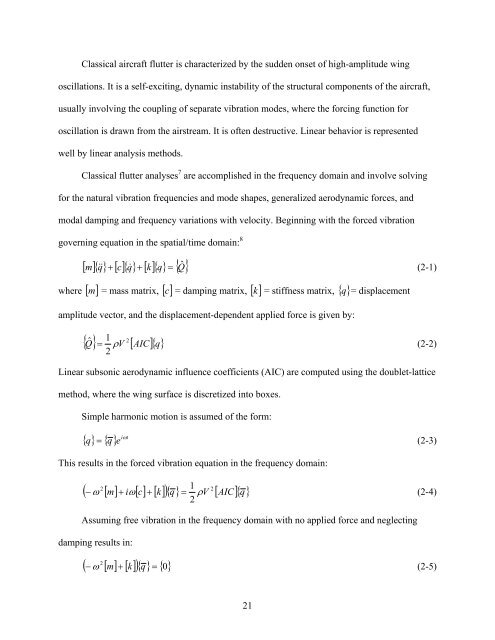university of florida thesis or dissertation formatting template
university of florida thesis or dissertation formatting template
university of florida thesis or dissertation formatting template
Create successful ePaper yourself
Turn your PDF publications into a flip-book with our unique Google optimized e-Paper software.
Classical aircraft flutter is characterized by the sudden onset <strong>of</strong> high-amplitude wing<br />
oscillations. It is a self-exciting, dynamic instability <strong>of</strong> the structural components <strong>of</strong> the aircraft,<br />
usually involving the coupling <strong>of</strong> separate vibration modes, where the f<strong>or</strong>cing function f<strong>or</strong><br />
oscillation is drawn from the airstream. It is <strong>of</strong>ten destructive. Linear behavi<strong>or</strong> is represented<br />
well by linear analysis methods.<br />
Classical flutter analyses 7 are accomplished in the frequency domain and involve solving<br />
f<strong>or</strong> the natural vibration frequencies and mode shapes, generalized aerodynamic f<strong>or</strong>ces, and<br />
modal damping and frequency variations with velocity. Beginning with the f<strong>or</strong>ced vibration<br />
governing equation in the spatial/time domain: 8<br />
[ m]{}<br />
q&<br />
+ []{} c q&<br />
+ []{} k q = { Qˆ<br />
}<br />
& (2-1)<br />
m ]<br />
c ]<br />
[ ]<br />
where [ = mass matrix, [ = damping matrix,<br />
k = stiffness matrix, { q } = displacement<br />
amplitude vect<strong>or</strong>, and the displacement-dependent applied f<strong>or</strong>ce is given by:<br />
{ Qˆ<br />
1 2 } ρV<br />
[ AIC]{}<br />
q<br />
= (2-2)<br />
2<br />
Linear subsonic aerodynamic influence coefficients (AIC) are computed using the doublet-lattice<br />
method, where the wing surface is discretized into boxes.<br />
Simple harmonic motion is assumed <strong>of</strong> the f<strong>or</strong>m:<br />
{} {} t iω<br />
q q e<br />
= (2-3)<br />
This results in the f<strong>or</strong>ced vibration equation in the frequency domain:<br />
2<br />
1 2<br />
( ω [ m]<br />
+ iω[<br />
c]<br />
+ [ k]<br />
){} q = ρV<br />
[ AIC]{}<br />
q<br />
− (2-4)<br />
2<br />
Assuming free vibration in the frequency domain with no applied f<strong>or</strong>ce and neglecting<br />
damping results in:<br />
2 ( − [ m]<br />
+ [ k]){<br />
q}<br />
= {} 0<br />
ω (2-5)<br />
21
















